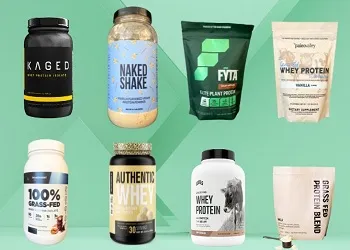Amino acids can be categorized based on their affinity to form hydrogen bonds with highly polar water molecules. Hydrophobic molecules have a low affinity to water, whereas hydrophilic molecules have a high affinity to bond with water. Glycine is a hydrophobic amino acid due to its single hydrogen atom R-group, which is nonpolar.
Quick Look
- Glycine is the simplest and smallest amino acid with a single hydrogen molecule as its side chain.
- Glycine is an excitatory and inhibitory neurotransmitter in the brain and nervous system via NMDA and glycine receptors.
- Some of glycine’s health benefits include supporting sleep, promoting better skin and joint health, and improving insulin sensitivity.
- Hydrophobic molecules have a low affinity for water, whereas hydrophilic molecules have a high affinity for water.
- Glycine is considered a hydrophobic or neutral amino acid due to its nonpolar side chain.
Table of Contents
What Is Glycine?

Glycine is a non-essential or conditionally essential amino acid naturally produced in the body in small amounts from three precursor compounds:
- Serine
- Choline
- Threonine
Glycine functions as both an excitatory and inhibitory neurotransmitter in the central nervous system (CNS) via N-methyl-D-aspartate (NMDA) type glutamate receptors and glycine receptors, respectively. In simple terms, glycine can increase or decrease nervous system activity based on what type of receptor it binds to.
Of the 20 amino acids, glycine is the second most widespread amino acid in the human body found in enzymes and proteins—it exerts widespread effects in virtually every system in the body.
What Does Glycine Do?
Glycine is a proteinogenic amino acid used to make functional proteins in the body. It’s found in the highest concentrations in collagen, the most abundant protein in the human body, serving as the foundation for all connective tissues.
Research shows that glycine can offer a range of health benefits throughout the body. Here’s a brief rundown.
- Skin and joint health: Glycine is a non-essential amino acid (NEAA) that is integral to collagen synthesis. It’s required in large amounts to satisfy the demands, and boosting glycine intake can promote cartilage regeneration by enhancing collagen synthesis, thereby strengthening skin, bones, joints, and other connective tissues.
- Memory: Glycine binds to the N-methyl D-aspartate receptor in the brain; the NMDA receptor complex is involved in long-term potentiation, which may be linked to learning and memory. Research suggests glycine may improve cognitive function without stimulant effects.
- Insulin sensitivity: Research shows that low glycine concentrations strongly predict glucose intolerance and type 2 diabetes. Increasing circulating glycine levels may improve insulin sensitivity and blood glucose regulation.
- Digestion: Glycine is an essential substrate for synthesizing various biomolecules, including glucose and glutathione (GSH). Glycine is also necessary for detoxification via conjugation of endogenous or xenobiotic toxins.
- Immunity: Glycine is involved in various aspects of the immune system, including the synthesis of glutathione, the body’s “master antioxidant” that helps to protect cells from oxidative damage and mitigate inflammation. Glycine is also required for the proliferation and antioxidative defense of leucocytes. Therefore, low glycine levels may impair immune responses.
- Serotonin production: Glycine supplementation has been shown to increase endogenous production of 5-hydroxytryptamine (5-HT), or serotonin, which is involved in mood, cognitive function, sleep, and other vital processes.
- Sleep: Glycine inhibits CNS activity and induces a calming effect on the brain, thereby lowering anxiety and stress levels, preventing overstimulation, and promoting a positive mental state conducive to sleep. It also inhibits the activity of orexin neurons—orexin is a hormone that regulates the sleep-wake cycles by inducing arousal, alertness, and attentiveness—to block wake-promoting signals within the brain.
Key takeaway: Glycine is an excitatory and inhibitory neurotransmitter important for skin and joint health, immunity, digestion, mood, sleep, and more.
Glycine Structure
Glycine is the simplest of all 20 amino acids. It’s composed of the following functional groups:
- Amino group (-NH2)
- Carboxyl group (-COOH)
- R-group
Unlike other amino acids, the side chain of glycine is a single hydrogen atom, making it the smallest and simplest amino acid of the bunch.
Take a look at the structure.

Hydrophobic vs Hydrophilic Molecules
Amino acids have several properties, but one commonly referred to is their affinity for water—we classify this as hydrophobic or hydrophilic.
- Hydrophobic: Compounds that naturally repel water; i.e., “water-fearing”. Hydrophobic molecules do not dissolve in water and instead form droplets.
- Hydrophilic: Compounds that have a strong affinity for water; i.e., “water-loving.” Hydrophilic molecules dissolve or mix well in water.
You can also classify amino acids based on whether they’re polar or nonpolar.
- Polar molecules are hydrophilic, meaning they are “water-loving” or have a strong affinity for water. For example, sugar will fully dissolve in water due to its numerous polar hydroxyl groups.
- Nonpolar molecules are hydrophobic amino acids, meaning they are “water fearing” or naturally repel water. For example, adding oil to water will cause the oil to form droplets because it’s hydrophobic.
Simply put, molecules are classified as polar or nonpolar based on the charges on the atoms bonded together to form the molecule.
When amino acids bond to form proteins, only their side chains interact with one another and the surroundings. The protein’s shape is determined primarily by the sequence of amino acids in that chain.
- Nonpolar amino acids have hydrophobic R-groups, so their side chains repel water. As a result, these amino acids are generally located in the core of the protein, away from contact with water.
- Polar amino acids have hydrophilic R-groups—they are attracted to water and actively participate in hydrogen bonding with the highly polar water molecules. Hydrophilic amino acids are usually located on the surface of proteins where they come into contact with the aqueous cell environment.
Here’s a breakdown of the differences between hydrophilic and hydrophobic molecules:
| Characteristic | Hydrophilic | Hydrophobic |
|---|---|---|
| Interaction with water | Attracts | Repels |
| Polar/nonpolar | Polar | Nonpolar |
| Water solubility | Soluble | Insoluble |
| Lipid solubility | Insoluble | Soluble |
| Molecular structure | Usually contains polar functional groups | Usually contains long hydrocarbons |
| Location in cell | Outer surface of cell membranes | Interior of cell membrane |
| Hydrogen bonding | Strong hydrogen bonds with water | Weak or no hydrogen bonds with water |
Key takeaway: Hydrophobic molecules repel water and are generally nonpolar molecules. Hydrophilic molecules have a high affinity for water and typically are polar molecules.
Is Glycine Hydrophobic or Hydrophilic?

That brings us to the question: is glycine hydrophobic?
The answer is yes, glycine is hydrophobic. Hydrophobic amino acids have little or no polarity in their R-groups. A lack of polarity means they cannot interact with highly polar water molecules, making them water-fearing.
In most cases, polarity is important when the amino acid contains the following elements as the “majority factor”:
- Nitrogen
- Oxygen
- Sulfur
If the side chains are primarily composed of carbons and hydrogens, you can assume the amino acid is hydrophobic. Since glycine’s R-group is a single hydrogen atom, it’s classified as nonpolar and hydrophobic.
You may also see glycine referred to as natural. It is the only proteinogenic amino acid with no chiral center. The single hydrogen side chain places glycine at a borderline between hydrophilic and hydrophobic categories, which can classify it as neutral.
In total, there are nine amino acids with hydrophobic side chains. These include:
- Glycine
- Alanine
- Valine
- Leucine
- Isoleucine
- Proline
- Phenylalanine
- Methionine
- Tryptophan
Frequently Asked Questions
What is the difference between hydrophilic and hydrophobic substances?
Hydrophilic substances have an affinity for water, meaning they attract and interact with water molecules, while hydrophobic substances repel water and tend to be nonpolar or have low polarity.
Can a molecule be both hydrophilic and hydrophobic?
Yes, some molecules can have both hydrophilic and hydrophobic regions. These are referred to as amphiphilic or amphipathic molecules. They have a polar or hydrophilic portion and a nonpolar or hydrophobic portion, making them ideal for forming structures like micelles or bilayers in water.
Is glycine hydrophobic or hydrophilic?
Glycine is hydrophobic due to its simple side chain of a single hydrogen atom. Although the remainder of the amine and carboxyl groups carry partial charges, glycine as a molecule is considered hydrophobic and nonpolar.
Why is glycine hydrophobic?
Glycine has two hydrogen atoms bonded to the central carbon. It’s the only symmetrical amino acid and, therefore, not chiral. Because hydrogen is nonpolar, glycine is a hydrophobic amino acid.














